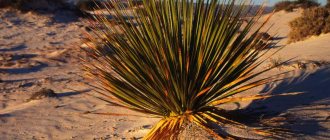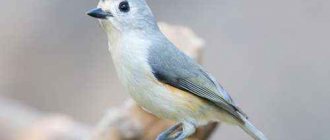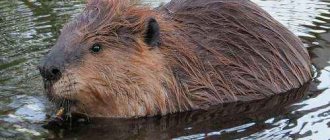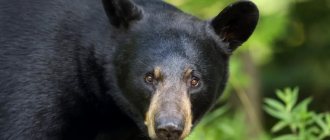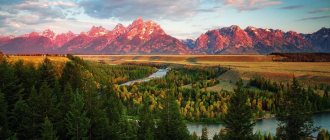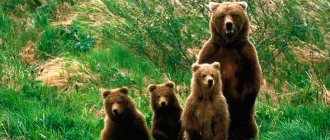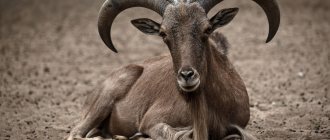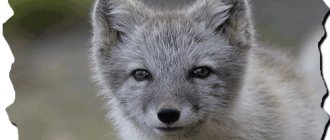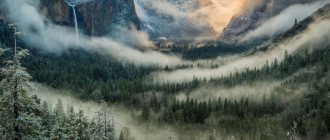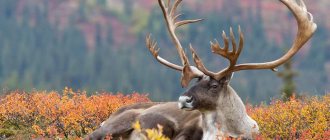Natural zones such as deserts and semi-deserts are characterized by a predominance of flat terrain, thin soils and a very specific animal and plant species composition. Deserts differ in soil composition and can be sandy, rocky, saline, clayey, and even arctic (snowy and snowless). Semi-deserts are transitional zones that combine the characteristics of deserts and neighboring areas, for example, steppes. Present on all continents, North America is no exception.
Arctic desert
Photo: NASA ICE/flickr
This belt is located mainly on the islands of the Canadian Arctic Archipelago and in Greenland. The average temperature here in January is -32 degrees Celsius, and in July - only 0 degrees Celsius. However, in winter there are severe frosts - down to -50º C and below. The soils are predominantly arctic desert, with permafrost. Only some representatives of the flora can grow in such conditions. Human fishing is also limited to hunting local animals. The Arctic desert is a unique natural area that is vulnerable due to climate change and thawing permafrost.
Lemming
This rodent from the hamster family is a prominent representative of the mammals of the tundra. Its body length is 10-15 cm, its tail length is up to 2 cm, its weight is 20-70 g. The lemming is active all year round. In winter, under snow cover, he feels quite comfortable. It feeds on lichens, moss, berries, grass and twigs of polar birches. In one day, a lemming can eat twice its weight. In search of food, these animals often make mass migrations. Thousands of rodents rush across the tundra in a furry wave in search of new territories. During the migration period of lemmings, predatory animals and birds literally swallow this easy prey.
Tundra and forest-tundra
Tundra and forest-tundra occupy almost the entire northern coast of the continent, ending at approximately 53 degrees N. w. The climate here is already less harsh for many species of animals to live in: in July the temperature stays steadily at +8-10 degrees Celsius, and in January it rarely exceeds -24 to -32º C. Tundra-gley and peaty soils predominate in this natural area . In some places, richer vegetation is already found, and people in this region not only hunt, but also engage in mining.
Caribou
This is the name given to reindeer that live in the polar tundra in the USA and Canada. Its body length is 150-220 cm, height at the withers is 80-150 cm, weight is 100-220 kg. Caribou are the only members of the deer family in which both males and females have antlers. They have an excellent sense of smell - they can easily find berries under deep snow and sedge along river banks. Their wide hooves allow them to move through loose snow and dig through it in search of food. Caribou, unlike other deer, feed not only on plant foods, but also on small rodents and birds. Reindeer are covered with thick and coarse hair, which protects them well from the cold. When a caribou senses danger, it can run at speeds of 80 km/h. He is also an avid nomad: caribou travel about 5,000 km per year.
Areas of altitudinal zonation
The altitudinal zones of North America are especially pronounced on the western coast of the continent, where the Cordillera mountain system extends, as well as in the east, where the Appalachian mountain system is located. At different altitude zones there are pronounced differences in nature:
- in the Canadian Cordillera, the differences are especially noticeable: meadows stretch from the shores, coniferous forests begin from 1000 m, and then mountain tundra and glaciers;
- in the subtropical zone of the Sierra Nevada, at a level of 1500 m, chaparral forests begin, alpine meadows - 3000 m. In the east of the mountain system there are practically no forests, only steppes and juniper forests are found, and deserts stretch between the mountains;
- The cordillera of the United States on the Pacific Ocean side is covered with shrubby oaks, and coniferous forests begin a little higher, and at around 3000 m there are alpine meadows.
The fauna of mountainous areas is not very diverse; only a few species of animals can live at an altitude of 3000 meters.
Marine mammals
killer whale
Killer whales are perfectly adapted to the harsh conditions of the tundra. A thick layer of fat accumulates from high-calorie foods and protects in ice water. Smart socially developed animals. Its large mass and size help it cope with sea lions, dolphins, and sharks. Because of their severity and strength, they are called killer whales.
Sea lion
The massive body of the pinniped animal has a streamlined shape and moves well in the water. On land, sea lions move on all fours. In the icy elements of the tundra, they are successful both in sea hunting and in open rookeries. Subcutaneous fat and thick fur protect the sea lion, which can dive to depths of up to 400 m and bask in the sun on the coast.
sea lions
Seal
Several species of seals live in the tundra. The sea feeds them, and on land communication and reproduction occur. The structure of the seal is universal for life under water: the body has no protrusions, the openings of the nostrils and ears are closed.
Holding your breath for up to 1 hour during a dive allows you to hunt and avoid surface predators by hiding in the water column. The front flippers act like oars, and the rear ones steer. Seal fur does not warm well, but the subcutaneous fat provides good protection in tundra conditions. Animals even sleep in ice-cold water.
Belukha
The beluga whale is protected from cold and damage by a thick layer of skin up to 15 cm and the same fatty lining. The absence of a fin on the back and a streamlined, stocky body contribute to a confident stay in the water.
The depth of their dive reaches 700 m. It is important for belugas to breathe air, so periodically they break through the ice in ice holes with their strong backs in winter. If a thick layer is formed, the animals may die.
Walrus
Larger than a seal in mass and size, reaching 5 m and 1.5 tons of weight. The main feature is powerful tusks. The walrus needs them to dig up the bottom and extract shellfish, its main food. He also needs such weapons for self-defense.
The giant is a predator; to enrich its diet, it can catch and eat seals. The longer the tusks, the higher the status of the walrus in the social group. On land, walruses feel more confident than other pinnipeds. They walk, rather than waddle from side to side. They help their brothers and take care of the walruses together.
Birds of the tundra
Swampy lowlands, numerous lakes, and rivers rich in fish attract birds that fly to feeding areas in the spring. The tundra comes to life and is filled with noise and screams. The noise of bird colonies and the roar of powerful tides are the sounds of the tundra.
Short-term warming contributes to the development of a huge number of blood-sucking insects, giving birds a chance to raise their chicks and raise them on the wing before migrating to their winter quarters. Not everyone flies away; the most resilient ones have learned to adapt to the world of ice and snow.
White Owl
The bird is considered a permanent resident of the tundra. She is very beautiful: her white plumage is fluffy and soft to the touch. Expressive yellow eyes with keen vision constantly look out for prey. The bird does not like trees; it sits on high stones, ledges, and hummocks to view the snowy plains.
The peculiarity of the white owl is that it eats only tasty morsels of prey. The rest goes to less fortunate hunters. In the absence of food, it can starve for a long time. The nesting of owls depends on the availability of food. Abundance influences large offspring. Lack of food leaves birds without offspring.
Ptarmigan
It is perfectly camouflaged in the snow, and in the summer it changes color and becomes pockmarked, like other animals of the tundra . what partridges are like in flight. It rarely flies, but runs beautifully. Digs snow holes in which it finds food and hides from enemies. Quiet, beautiful birds are the object of hunting for many other inhabitants of the tundra.
Tundra swan
It is the smallest in size among its waterfowl relatives. They feed on algae, fish and coastal vegetation. The grace and elegance of birds have become symbols of beauty. Created pairs of swans are inseparable throughout their lives.
Large nests are built on high ground and lined with their own feathers and the feathers of other birds. The chicks are not left alone and are protected by strong wings and beaks. The young grow stronger in 40 days. The short summer hurries the birds. The small tundra swan is listed in the list of animals in the Red Book of the Tundra . Shooting of birds is prohibited.
Pictured are tundra swans
Loons
The oldest birds that have survived to the present day. Their places of promise are becoming fewer and fewer, and the birds cannot adapt to changes. They remember their territories for years. Their life is connected with bodies of water; they move on land with difficulty. A pointed beak, elongated body and short wings distinguish loons from ducks. Excellent divers for fish and in case of danger.
loon bird
Oatmeal crumble
Migrant. Settles in thickets of tundra bushes and dwarf birch, occupying ground layers. Recognizable by a red stripe with a black border along the crown. The singing of the oatmeal is high and gentle. Nesting sites change annually. They fly to China for the winter.
In the photo there is a bunting bird
Siberian crane (white crane)
A large bird with a long red beak and high legs. Siberian crane nesting sites can be seen in low-lying wetlands. Conservation of birds is a difficult task due to their demanding conditions: an aquatic environment with viscous soil. The voice of the white crane is drawn-out and sonorous.
Peregrine falcon
The large falcon loves open areas, so in the vastness of the tundra they have extensive nesting areas, up to 10 km from the neighboring one. Peregrine falcons do not hunt in their territories, so other birds settle next to them, finding protection from birds of prey that the peregrine falcons drive away.
Mating pairs of falcons last a lifetime. Birds have their own hunting style. They swoop down on their prey and grab it with their paws. Finish off with the beak only when necessary. They eat prey on stones, ledges, stumps, but not on the ground.
Peregrine falcon bird
Flat-nosed phalarope
Settles in low-lying areas of the tundra, where lakes and numerous puddles accumulate. They feed on insects, mollusks, larvae, and small animals. Like wind-up toys, the size of a sparrow, they are constantly moving their paws. Unlike other birds, they are not shy and will let you get very close.
Caring for the offspring through incubation rests with the male. After laying eggs, the female flies away. The male, having fulfilled his parental duty, leaves the tundra with a group of brothers. The grown young animals fly to the winter quarters on their own.
Flat-nosed phalarope
Kamenushka
One of those birds that is able to spend the winter in the lifeless desert tundra. Bright ducks stay at the sea edge, in shallow waters, in ice holes. In summer, they move to fast rivers of the mountain tundra to nest.
Stonewheat birds
Tundra Horned Lark
They are among the first to arrive in the tundra. Thanks to the original design and two black horns, the lark is easy to recognize among birds. The size of a large ruffled sparrow. They love to swim. They fly in pairs or small flocks. Breeds in the tundra on hilltops. The singing is abrupt and ringing.
Tundra Horned Lark
animals living in the tundra , but there are absolutely no reptiles among them. But there is an abundance of blood-sucking insects. There are 12 species of mosquitoes alone. In addition to them, animals suffer from gadflies, midges, and black flies. The lives of all living organisms depend on each other, maintaining an amazing balance in the tundra natural zone.
Taiga
Passes between 53 and 48 degrees N. w. in the east of the mainland and between 65 and 55 degrees N. w. - in the West. The climate here is already milder, in winter the thermometer rarely drops below -24º C, and in summer the weather is pleasant - on average +16º C. The soils in this natural zone are predominantly podzolic, which ensures good growth of trees. People in the taiga are engaged in hunting, mining, and deforestation.
Peers of the mammoth
Musk oxen have existed on Earth for more than 5 million years. This has been established by paleontologists. In ancient times, musk oxen lived in Europe and Asia. It is assumed that this animal moved through the isthmus from Asia to Canada, which became its habitat for many years. Outwardly, musk oxen look like prehistoric animals: they have shocks of long matted hair hanging from them, just like a mammoth. Science knows of 2 ancient species of musk oxen, and only one of them survived.
Mammoth is an extinct genus of large mammals
Mixed and broad-leaved forests
Regions such as the Great Lakes and the Atlantic coast belong to this natural zone. In summer, the weather here is warm - from +16 to 24 degrees Celsius, and in January there are rarely severe frosts, the average temperature stays at -16 degrees Celsius. Brown and gray forest soils are predominantly found. Favorable conditions contribute to a significant diversity of animal and plant species.
Arctic fox
A predatory mammal of the canine family, which is also called the polar fox. The length of its body reaches 75 cm, the length of the tail is 30 cm. The arctic fox weighs 2-9 kg. This animal lives beyond the Arctic Circle, on the coast of the Arctic Ocean, in the tundra and forest-tundra zones. Its usual food is tundra rodents, primarily lemmings, chicks and eggs of birds nesting in the tundra, as well as carrion and sea waste. The Arctic fox is perfectly adapted to the cold and does not freeze even in the most severe frosts. Its dense coat perfectly retains body heat. Even the pads of the Arctic fox's paws are covered with hair.
Hardleaf forests
Located on a narrow strip of the west coast of North America in California. Hardleaf forests occupy a small area relative to other biomes of the continent. Up to 1000 mm of precipitation falls in these forests annually, most of which occurs in winter.
The soils here are mainly red and brown (chestnut). The climate is moderate, snow occasionally falls, but disappears quickly. Hardleaf forests closely border deserts, savannas, as well as forests of temperate latitudes, so the flora and fauna are in many ways similar to these zones.
Representatives of the flora:
- cork and holm oaks;
- heather;
- myrtle;
- arbutus;
- eucalyptus;
- wild olives.
The hard-leaved forests are home to wolves, mongooses, porcupines, and many birds.
Climate
Since deserts are located in several climatic zones, the climate in them is formed due to the action of air masses that dominate in these areas. They are characterized by a sharp difference in daily and annual temperature values. Therefore, North American deserts are divided into two types:
- cold: these include the northern deserts of the Great Basin, where significant altitudes and winter precipitation (mostly snow) prevail;
- hot, located in the subtropics. These are the Mojave desert with its winter precipitation, Chihuahua with the predominance of summer rains and Sonora - here precipitation is year-round.
The climate of these deserts can be described as warm and arid. The air here has very low humidity and transmits a significant portion of solar radiation. Sharp fluctuations between day and night temperatures are characteristic.
The deserts of North America are characterized by constant strong winds, which cause dust storms and even tornadoes. These phenomena are usually caused by convective air currents arising due to its strong heating.
Animals and plants of natural areas of North America
Even in the Arctic deserts and the hottest regions of North America there are unique inhabitants. Thus, in the northern zones of the Arctic there are lichens and mosses that serve as a source of food for lemmings and musk oxen, the most numerous animals in the region. You can also see amazing polar wolves here, and on the glaciers there are huge walruses with terrifying tusks. One of the characteristic inhabitants of cold deserts is the polar bear.
The coastal waters of the Arctic are inhabited by seals, bowhead whales, and killer whales occasionally visit. And among the birds are partridges, eiders and arctic gulls.
In the tundra there is again an abundance of mosses and lichens. And the fauna becomes richer: reindeer, arctic foxes, hares and owls complement partridges, gulls and polar bears.
The taiga forest is an abundance of coniferous vegetation. Here you can find pines, black and white spruces, as well as medicinal balsam fir. Aspen, birch and other deciduous trees are practically not found here. The fauna of the taiga forest is diverse:
- moose, wapiti;
- grizzly;
- wolverines and beavers;
- martens, squirrels, muskrats;
- owls, nutcrackers, wood grouse, woodpeckers and other species of birds.
Mountain forests are the wealth of the Rocky Mountains. Relict trees and alpine animals are found here. Elk, foxes, goats and bighorn sheep are the predominant inhabitants of the region. Also found here are hares, prairie dogs, coyotes, baribals and grizzly bears. The bald eagle, the symbol of the United States, lives in this area.
But in the mixed forests located in the east, a unique variety of trees grows: beech, chestnut, pine and fir, oak, maple and spruce. In all this splendor live foxes, wolves, squirrels, grizzlies, moose, bison, raccoons, skunks, and chipmunks.
In the steppes, the vegetation is more sparse, but there are a lot of herbs: wheatgrass, feather grass, bluegrass, and grass. Among the animals, prairie dogs and gophers predominate.
Deserts and semi-deserts are inhabited mainly by cacti, lizards, snakes, scorpions and spiders. Hares, foxes and coyotes are occasionally seen. In tropical forests, the vegetation is incredibly rich: cypresses, oaks, ferns, palms. This diversity is home to wild cats, reptiles and colorful birds.
The natural zones of North America are almost as diverse as the belts of Eurasia. There are many amazing species of animals and plants found here, some of which require careful protection.
Atlas, Cities and countries, seas and oceans. Around the World, Mysteries of the 20th century, The whole world is in your hands
This ecoregion covers the northern continent of North America. Of course, it has many similarities with the Eurasian tundra: many species of fauna living in North American territories are either relatives of Eurasian species or are distributed in general on both continents. The problems faced by tundra defenders are also largely similar: the development of oil and gas fields leads to catastrophic pollution of the unique natural world.
The Arctic tundra is an area of low, flat, marshy coastal plains covered with lakes filled with melted ice.
A LINK IN THE TUNDRA CHAIN The tundra of North America is part of the natural tundra zone of the Northern Hemisphere.
The American tundra zone occupies the northern part of the North American continent and runs from Northern Alaska along the coast of Hudson Bay to the north of Labrador and Newfoundland. In the east, where the influence of the Labrador Current is felt, the tundra extends to 55-54° N. w.
To the north of the border of distribution of broad-leaved and coniferous trees there are shrub tundras, where such unpretentious plants as creeping heather, dwarf and polar birch, willow, alder and low shrubs predominate.
Since the tundra of North America is located in areas where the waters of the Arctic Ocean extend deep into the land, there is a very confusing picture of the wind regime, with frequent changes in direction and different strengths. Therefore, the geography of distribution of tundra plants is extremely complex. Since this area is in many ways similar to the forest-tundra and taiga, it is not surprising that, quite suddenly for the traveler, the low vegetation bent in all directions in open areas is suddenly replaced by tall trees in river valleys and at the foot of the mountains.
However, as you move north, the predominance of true tundra with mosses, lichen, sedge and cotton grass becomes more and more noticeable, and the woody areas disappear completely.
The peculiarity of the North American tundra is the wide distribution of the Arctic landscape - low, flat and swampy coastal plains. The vegetation here is sparse, with a short growing season and is represented mainly by mosses and lichens. It does not form an even cover and often sows cracks in the soil formed due to severe frosts. Where ice and earth are mixed, ice wedges and heaving mounds are formed, called pingos in Sulfur America.
The climate of the North American tundra is very harsh. The wind here gains extreme strength, it blows snow into the lowlands, where snow drifts form, which persist even in summer. It is precisely because of the lack of snow on the plains that the soil freezes and does not have time to warm up during the short summer. Over a larger area, the climate of the Arctic tundra is more humid and damp than within the boundaries of the subpolar tundra, which extends from American Alaska eastward to Canadian Quebec.
Separately, the tundra of the northwestern North America is distinguished - the Alaska Range and the St. Elias Mountains. This ecoregion includes the mountains of interior Alaska, which are permanently covered with ice and snow. The rare areas that remain ice-free are rocky, rocky, and alpine tundra.
The occupations of the local population in the tundra of both North America and Eurasia are similar. This includes reindeer herding (the Arctic tundra becomes vast pastures for reindeer in the summer), hunting sea animals (according to quotas from the Ministry of Natural Resources) and fishing. Crafts include bone carving and sewing clothes and shoes from deer skins. There are no large cities in the tundra of North America.
The tundra zone occupies the northern coast of North America. The southern border of the tundra in the west passes near the Arctic Circle, to the east it deepens into more southern latitudes, capturing the coast of Hudson Bay and the northern part of the Labrador Peninsula.
TUNDRA IS UNDER THREAT
The biggest threats facing the North American tundra come from oil and gas pipelines, hydrocarbon development, and global warming.
The fauna of the North American tundra is much richer in species composition than the vegetation. Large mammals are dominated by caribou, brown bear, polar wolf, arctic weasel, polar bear and musk ox, small mammals are fox, arctic fox, lemming and ermine, and birds are white goose, brant, white and tundra partridge. , Alaskan plantain (a bird of the Bunting family) and the white owl, among marine mammals - seal, walrus, narwhal, beluga whale, bowhead whale. There are a lot of fish in the rivers: lake trout, whitefish, grayling.
However, only a very small part of the flora and fauna of the North American tundra is characteristic only of these places. It took specialists a lot of time to figure this out. For example, at the dawn of the study of animals in North America, caribou and Eurasian reindeer were considered different species (today in America there are two subspecies of caribou - tundra and forest), and along with them - American and Eurasian moose. Later studies of the movement of species along the Bering Isthmus, which once connected North America and Eurasia, showed that all these species are related or even identical.
There are many examples of this. The gray-haired marmot is a typical inhabitant of the mountainous American tundra - a brother of the mountain-tundra Siberian black-capped marmot. The long-tailed ground squirrel, an inhabitant of the American tundra, also lives in Siberia. The musk ox could be called a “Native American”, if you did not know that it disappeared from the tundras of Eurasia during the times of primitive people, who mercilessly destroyed the animal’s population.
In general, most American tundra endemics are represented by relatively young species that have recently separated from their closest relatives from the same genus.
A completely unique phenomenon for the tundra of North America is the spread of certain species of birds that arrive here only in the summer months: among such species that fly to the Labrador Peninsula, even several species of tropical hummingbirds and juncos have been spotted (a genus of passerine birds from the bunting family, characteristic only of North America ), savannah bunting (only occasionally found in the tundra of Chukotka), Canada goose (the most common species of game bird here).
The further north you go, the poorer the fauna is and the more its life is connected with the sea: these include auks and gulls nesting on the rocks, and pinnipeds and polar bears. A rare visitor from the depths of the southern tundra is the Arctic fox and snow bunting.
The problems associated with tundra pollution are largely similar for different areas due to the nature of the minerals being mined here, their storage and transportation. Despite the strictest controls and multimillion-dollar fines for leaks from oil pipelines, environmental pollution continues, deer refuse to use special passages, and road trains tear off the top protective layer of tundra soil with their tracks, which takes almost a hundred years to restore.
FUN FACTS
■ The Mackenzie River was discovered and first navigated by Scottish explorer Alexander Mackenzie in 1789. Its original name was Disappointment, which literally means “disappointment” in English. Having given the river such a strange name, Mackenzie expressed his own frustration that it led him not to the Pacific Ocean, but to the Arctic Ocean.
■ The term “pingo” as a typically North American designation for a swelling mound first appeared in 1938. It was borrowed from the Eskimos by the Danish-Canadian botanist Alf Porslig.
■ The easiest way to get deep into the North American tundra is to drive along the Trans-Alaska Pipeline, which runs from Barlow to the Pacific port of Valdez and poses the greatest threat to the ecology of the North American tundra.
■ Tundra Labrador tea plant has red leaves to use chlorophyll and the sun's heat to retain internal heat. None of the tundra animals eat it.
■ The North American tundra receives less annual precipitation than the Mojave Desert.
ATTRACTIONS
■ Natural: Gates of the Arctic National Park and Preserve (Alaska, USA), Kobuk Valley National Park (Alaska, USA), Wapusk and Yukkusaiksalik National Parks (Hudson Bay Coast, Canada), Gross National Park Morne (Newfoundland Island, Canada), Torngat Mountains National Park (Labrador Peninsula, Canada).
Atlas. The whole world is in your hands #255
Read in this issue:
NECROPOLIS OF SAKKARA. The most ancient place of eternal rest for kings and their entourage is KANCHENJANGA. Five treasures of the great snows JERICHO. Under the biblical palm trees TUNDRA OF NORTH AMERICA. Between ice and swamps KARNATAKA. Monsoon state of LUCCA. Under the patronage of Saint Paulinus
Like
SocButtons v1.5
Steppes and forest-steppes
Steppes and forest-steppes are located in the temperate and subtropical climate zone. The prairies are located slightly south of the taiga on the Great and Central Plains. A forest-steppe subzone stretches across the Great Plains from west to east. The steppe zone is heterogeneous. It receives no more than 600 millimeters of precipitation annually. The entire territory is cut up by gullies and ravines. The main types of soils are chestnut, meadow-chernozem, gray and chernozem.
Almost 80 percent of the entire plant community is represented by the bearded plant. Fescue, feather grass and buffalo grass also grow in these areas. Wildlife consists of bison, prairie foxes, rabbits, opossums and prairie dogs.
Steppe fox
Buffalo
Rodents and hares
Lemming
The animal is only ten centimeters in size from the hamster family, with a diet similar to that of ordinary voles: forbs, moss, cereals.
In the summer, lemmings can be of a wide variety of colors, both one color and variegated. In winter, these rodents usually lighten in color, some individuals become almost white.
Like many hamsters, the lemming is a solitary animal, females occupy a certain territory, males do not have such a tendency, adhering to a wandering lifestyle. In winter, small-scale living in burrows is possible.
Several species of predatory animals depend heavily on these small animals.
If the lemming population declines in tundra areas, arctic foxes go into the taiga to feed, and owls stop breeding altogether, since they will have nothing to feed their chicks.
White hare
A large representative of lagomorphs - body length reaches an average of sixty centimeters, found in the tundra of western Siberia. They are distinguished from hares by shorter ears and wide paws, as well as a more noticeable change in color depending on the time of year.
Whites are solitary animals; they usually occupy a certain territory and defend it. But they also have seasonal school migrations.
The basis of nutrition is herbivorous, as well as mushrooms and berries. Due to the lack of minerals in the body, there are often scenes in which the hare willingly gnaws on the bones or shed antlers of large herbivores.
